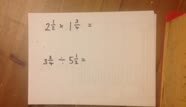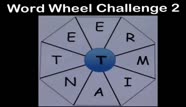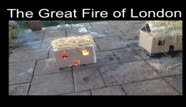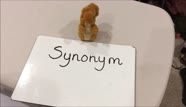-
Staying safe / Outside of home
My ball is near the train track
David has been been playing with his football to close to the train more »
David has been been playing with his football to close to the train tracks and now he has lost it. He wonders whether he is allowed to go near the track to get it back. This video is designed to stimulate conversation so no possible answers are identified.
less « -
Staying safe / Outside of home
This man keeps touching me!
David is on a train. The stranger sat next to him keeps touching him and more »
David is on a train. The stranger sat next to him keeps touching him and David wonders what he should do (there are a number of things he could do - move to an empty seat, ask the man to stop it, ignore it and hope that it stops).
less « -
Staying safe / Outside of home
Why are these lights flashing?
David is out walking and arrives at a level crossing. Suddenly the lights more »
David is out walking and arrives at a level crossing. Suddenly the lights start flashing, followed soon afterwards by the barriers descending. David wonders why (there's a train coming!).
less « -
Life skills / Essential
Not enough bus fare
David is waiting for a bus and realises that he hasn't got enough money more »
David is waiting for a bus and realises that he hasn't got enough money to pay for his fare. What should he do? This video is designed to act as a stimulus for discussion. For this reason, no suggested actions are made.
less « -
Staying safe / Outside of home
Can I drink this?
David is being given a lift in his friends car. He finds a bottle of Diet more »
David is being given a lift in his friends car. He finds a bottle of Diet Coke lying on the car floor. He wonders if it's okay to drink it. He doesn't spot that it is a very strange colour! This video is designed to stimulate conversation so no possible answers are identified.
less « -
Social skills / Everyday life
This is the wrong drink!
David is in a café. The waitress brings him the wrong drink. David more »
David is in a café. The waitress brings him the wrong drink. David wonders what he should do.
less « -
 Y6 / Art and Design
Y6 / Art and DesignUsing pastels to draw a strawberry
This video, shot in real time, demonstrates how to create a large picture more »
This video, shot in real time, demonstrates how to create a large picture of a strawberry using pastels. There is no commentary added, allowing you to lead discussions, pause and play as appropriate. There are a number of videos I have created, showing how to quick draw a range of fruit ...
less « -
Staying safe / Outside of home
Should I say what I'm listening to?
A young man is sat on a bench at the park, listening to music through his more »
A young man is sat on a bench at the park, listening to music through his headphones. A stranger sits down next to him and touches his shoulder to get his attention. The stranger asks what the young man is listening to. The young man wonders what, if anything he should say in reply.
less « -
Key Stage 2 / English
Identifying phrases and clauses
Here's a simple explanation of the difference between a phrase and a more »
Here's a simple explanation of the difference between a phrase and a clause.
less « -
 Y6 / Art and Design
Y6 / Art and DesignUsing pastels to draw a kiwi fruit
This video, shot in real time, demonstrates how to create a large picture more »
This video, shot in real time, demonstrates how to create a large picture of a kiwi fruit using pastels. There is no commentary added, allowing you to lead discussions, pause and play as appropriate.
less « -
Staying safe / Outside of home
Why are these barriers down?
David is out for a walk and arrives at a level crossing. The barriers are more »
David is out for a walk and arrives at a level crossing. The barriers are down and he wonders why the barriers are down (there's a train about to cross over the road).
less « -
 Y6 / Art and Design
Y6 / Art and DesignUsing pastels to draw an orange
This video, shot in real time, demonstrates how to create a large picture more »
This video, shot in real time, demonstrates how to create a large picture of a strawberry using pastels. There is no commentary added, allowing you to lead discussions, pause and play as appropriate. There are a number of videos, all of which follow the same format, allowing you to ...
less « -
Staying safe / Outside of home
What should I say to this stranger?
A young man is walking along eating some sweets. A man blocks his path more »
A young man is walking along eating some sweets. A man blocks his path and tells him that he can't pass unless he hands his sweets over. The young man wonders what he should say.
less « -
 Y2 / Geography
Y2 / GeographySafety in the countryside
A fun video teaching children about different hazards and how to stay more »
A fun video teaching children about different hazards and how to stay safe in the countryside. Could be useful to watch before taking children on a visit to the countryside.
less « -
 Y2 / Mathematics
Y2 / MathematicsAdding a 2digit Number to a 2digit Number
This video introduces children to adding a 2digit number to 2digit number more »
This video introduces children to adding a 2digit number to 2digit number using Base 10! The method used is explained step by step and ends with a number sentence to encourage children to have a go for themselves!
less « -
Staying safe / Outside of home
My ball has landed in the river
David is playing with his football near to a river and the ball has more »
David is playing with his football near to a river and the ball has landed in the water. It is close to the edge, so the viewer is asked to consider whether it is safe for him to reach out and try to get it back.This video is designed to stimulate conversation so no possible answers are identified.
less « -
 11-16 / Mathematics
11-16 / MathematicsAdding fractions
Adding fractions using the grid method
Adding fractions using the grid method
less « -
 Key Stage 2 / Mathematics
Key Stage 2 / MathematicsDivide by Repeated Subtraction
This video introduces children to an alternative approach on how to more »
This video introduces children to an alternative approach on how to tackle a division calculation. Simple division number sentences are used to show children how to divide by using repeated subtraction on a blank number line. After a variety of examples, children are encouraged to have a ...
less « -
 11-16 / Mathematics
11-16 / MathematicsMultiplying fractions
How to multiply fractions
How to multiply fractions
less « -
Staying safe / Outside of home
I've dropped money on the train track
David is crossing the train tracks at a level crossing. As her walk more »
David is crossing the train tracks at a level crossing. As her walk across he drops some money onto the rails. he wonders what he should do (he should leave it - perhaps ask for help from station staff if he really wants it back!).
less « -
 Y6 / Art and Design
Y6 / Art and DesignUsing pastels to draw an apple
This video, shot in real time, demonstrates how to create a large picture more »
This video, shot in real time, demonstrates how to create a large picture of an apple using pastels. There is no commentary added, allowing you to lead discussions, pausing and playing as appropriate.
less « -
 11-16 / Mathematics
11-16 / MathematicsDividing fractions
How to divide fractions
How to divide fractions
less « -
 11-16 / Mathematics
11-16 / MathematicsFinding the nth term of a linear sequence
A video showing how to work out the nth term of a linear sequence
A video showing how to work out the nth term of a linear sequence
less « -
Clubs
Learning the Cascade pattern
This series of videos will help you to develop the most basic 3-ball more »
This series of videos will help you to develop the most basic 3-ball juggling pattern, known as Cascade.
less « -
 Key Stage 1 / Mathematics
Key Stage 1 / MathematicsDivide by Repeated Subtraction on a Number line
This video models how to use a number line to divide by using repeated more »
This video models how to use a number line to divide by using repeated subtraction. Children are shown how to use this method step by step and are then given the opportunity to have a go themselves. Before introducing children to this concept, ensure your children are secure with counting ...
less « -
11-16 / Mathematics
Pythagoras' theorem - shorter side
Finding the shorter side using BSL
Finding the shorter side using BSL
less « -
 Y6 / Physical education
Y6 / Physical educationRugby: Passing the ball
Passing the ball
Passing the ball
less « -
 11-16 / Mathematics
11-16 / MathematicsConverting improper fractions to mixed numbers
How to convert from improper fractions to mixed numbers.
How to convert from improper fractions to mixed numbers.
less « -
 11-16 / Mathematics
11-16 / MathematicsSubtracting fractions
Subtracting fractions using the grid method
Subtracting fractions using the grid method
less « -
 Y2 / Mathematics
Y2 / MathematicsNumber bond rhyme 0-10
A simple rhyme to help children learn their number bonds to 10
A simple rhyme to help children learn their number bonds to 10
less « -
 Key Stage 1 / Physical education
Key Stage 1 / Physical educationV-Sit Balance
Use this video as a practical demonstration of how to perform a V-Sit more »
Use this video as a practical demonstration of how to perform a V-Sit Balance. As part of the video, key teaching points are highlighted for children to use as a visual reminder of what they need to do! Encourage children to start and end in a tuck position and hold the balance for at ...
less « -
 11-16 / Mathematics
11-16 / MathematicsSubtracting negative numbers
A simple rule for subtracting negative numbers.
If you see a minus more »A simple rule for subtracting negative numbers.
less «
If you see a minus NEXT TO minus, turn them into a plus and do the sum. -
 11-16 / Mathematics
11-16 / MathematicsWorking out specific terms using the nth term rule of a sequence
A video demonstrating how to work out the 1st term, the 2nd term, the 3rd more »
A video demonstrating how to work out the 1st term, the 2nd term, the 3rd term etc of sequence when you are given the formula for the nth term.
less « -
 Y2 / English
Y2 / EnglishStory settings
This video contains real footage of a woodland walk. It encourages more »
This video contains real footage of a woodland walk. It encourages learners to think about how to use their senses to identify words which will improve a simple sentence. The woodland setting offers lots of opportunities for learners to develop their own descriptive writing. The video ...
less « -
 Y6 / Mathematics
Y6 / MathematicsLong multiplication using the box/grid method
Learning how to do long multiplication using the box method.
Learning how to do long multiplication using the box method.
less « -
 11-16 / Mathematics
11-16 / MathematicsAdding negative numbers
A simple rule for adding negative numbers.
If you see a plus NEXT more »A simple rule for adding negative numbers.
less «
If you see a plus NEXT TO a minus, rub out the plus and do the sum. -
Staying safe / Outside of home
I've dropped my ticket on the tracks!
David is at the train station. He's accidentally dropped his ticket on to more »
David is at the train station. He's accidentally dropped his ticket on to the train tracks and wonders whether it would be okay to climb down and get it (it is never okay to climb on to the tracks. He Should talk to the station staff instead).
less « -
 Y2 / Mathematics
Y2 / MathematicsCyril the squirrel learns to add 2 numbers together using rounding
This video shows you how to add 2 numbers together by rounding one number more »
This video shows you how to add 2 numbers together by rounding one number to the nearest whole ten
less « -
SEND / Post-16
Body signs - set up
Here's how to set up for body signs. I explain the importance of more »
Here's how to set up for body signs. I explain the importance of consistency and the reasons why we do it the way that we do.
less « -
Clubs
Learning the Cascade pattern
Learning how to perform the Cascade juggling pattern.
Learning how to perform the Cascade juggling pattern.
less « -
Clubs
Learning the Cascade pattern
Learning how to perform the basic Cascade pattern.
Learning how to perform the basic Cascade pattern.
less « -
 FS2 / Mathematics (EYFS)
FS2 / Mathematics (EYFS)Counting to 10
Counting to 10 using your fingers
Counting to 10 using your fingers
less « -
 Y2 / Physical education
Y2 / Physical educationThrowing at a Target
Throwing at a target
Throwing at a target
less « -
 Key Stage 1 / Physical education
Key Stage 1 / Physical educationKnee Balance
Use this video as a practical demonstration of how to perform a Knee more »
Use this video as a practical demonstration of how to perform a Knee Balance. As part of the video, key teaching points are highlighted for children to use as a visual reminder of what they need to do! Encourage children to start and end with their arms by their side and hold the balance ...
less « -
 11-16 / Mathematics
11-16 / MathematicsMultiplying with negative numbers
Simple three stage rule for multiplying negative numbers.
1. more »Simple three stage rule for multiplying negative numbers.
less «
1. Forget the minus signs
2. Do the sum
3. The answer is negative if the numbers you started with were one positive and one negative. -
11-16 / Mathematics
Converting mixed numbers to improper fractions
How to convert from mixed numbers to improper fractions.
How to convert from mixed numbers to improper fractions.
less « -
 Y2 / Physical education
Y2 / Physical educationInstructions of how to dance to 5,6,7,8 with Mrs Hempell!
This is all you need to know about the dance moves to 5,6,7,8 by Steps. more »
This is all you need to know about the dance moves to 5,6,7,8 by Steps. Watch this video so that you can practise the moves with a voice over and then when you know all the moves play the video without the VoiceOver and see how good you are!
less « -
 11-16 / Mathematics
11-16 / MathematicsFour rules- fractions and whole numbers
What do you do when you have a sum where one of the numbers is a fraction more »
What do you do when you have a sum where one of the numbers is a fraction and the other number is a whole number?
less « -
 Key Stage 2 / English
Key Stage 2 / EnglishComplex apostrophes for possession
This video explores more complex apostrophe use and how it denotes more »
This video explores more complex apostrophe use and how it denotes possession in a range of situations.
less « -
 Key Stage 1 / Mathematics
Key Stage 1 / MathematicsDivide by Sharing
This video provides children with an opportunity to learn how to divide more »
This video provides children with an opportunity to learn how to divide by sharing through a practical and pictorial representation. At the end of the video, children are encouraged to use what they have learned to have a go themselves with number sentences provided by the teacher in ...
less « -
Life skills / Essential
This bus is the wrong colour...
David is expecting a blue bus to come along as usual. However, when it more »
David is expecting a blue bus to come along as usual. However, when it arrives, the bus is pink. It says that it's going to the right destination - should he catch it? This video is designed to stimulate discussion so it is left opened ended....
less « -
 11-16 / Mathematics
11-16 / MathematicsThe four rules with mixed numbers
Don't work with mixed numbers! This video shows students what to do when more »
Don't work with mixed numbers! This video shows students what to do when they are asked to add, subtract, multiply or divide with mixed numbers.
less « -
 11-16 / Mathematics
11-16 / MathematicsPercentage increase and decrease- multiplier method
Description...an explanation of how to use multipliers to increase or more »
Description...an explanation of how to use multipliers to increase or decrease an amount by a percentage in one step
less « -
 Y2 / English
Y2 / EnglishCyril learns about using different words for "said" in his writing.
Cyril learns that using the word "said " all the time can make his more »
Cyril learns that using the word "said " all the time can make his writing a bit boring! Here he finds different words that he can use to make it more interesting for the reader.
less « -
Key Stage 2 / English
Text Visualisation
This video demonstrates how to take key imagery from a piece of text to more »
This video demonstrates how to take key imagery from a piece of text to create an actual picture. Great drawing skills are not needed here, being able to create a physical representation, drawing directly from the text is all that matters.
less « -
 11-16 / Mathematics
11-16 / MathematicsDividing with negative numbers
Simple three stage rule for dividing negative numbers.
1. Forget more »Simple three stage rule for dividing negative numbers.
less «
1. Forget the minus signs
2. Do the sum
3. The answer is negative if the numbers you started with were one positive and one negative. -
 Y6 / English
Y6 / EnglishWord Wheel Challenge 2
A fun, spelling-focussed game. The 9-letter word is terminate.
A fun, spelling-focussed game. The 9-letter word is terminate.
less « -
Staying safe / Outside of home
Is this a safe place to play?
David is playing with his football near to a river. The viewer is asked more »
David is playing with his football near to a river. The viewer is asked to consider whether it is safe for him to do so. This video is designed to stimulate conversation so no possible answers are identified.
less « -
Collective worship
Conkers
Finding out where conkers, and the game of conkers comes from.
Finding out where conkers, and the game of conkers comes from.
less « -
Staying safe / Outside of home
The train is here! Where do I stand?
He's on the platform waiting for his train. His train is arriving at the more »
He's on the platform waiting for his train. His train is arriving at the platform. David wonders where he should stand (he should stand well back and wait for people to get off, before trying to get on himself).
less « -
SEND / Post-16
Introduction to PECS
An introduction to PECS (Picture Exchange Communication System).
An introduction to PECS (Picture Exchange Communication System).
less « -
 Key Stage 2 / English
Key Stage 2 / EnglishApostrophes for Possession
This is a simple tutorial that explains where to put the apostrophe in a more »
This is a simple tutorial that explains where to put the apostrophe in a word to show possession.
less « -
Y2 / Mathematics
Doubling using Cubes
This video introduces children to the concept of doubling and what it more »
This video introduces children to the concept of doubling and what it means using cubes. The video shows how to work out doubles up to double 5 and then children are encouraged to use the same method to work out doubles up to double 10!
less « -
Key Stage 2 / English
Ible and able spelling patterns
This video explores the spelling correction vention of when to use able more »
This video explores the spelling correction vention of when to use able or ible as a suffix.
less « -
 11-16 / Mathematics
11-16 / MathematicsRepeated percentage change- Using a multiplier
A video showing students how to use a multiplier to carry out more »
A video showing students how to use a multiplier to carry out calculations involving repeated percentage changes
less « -
 Y2 / Mathematics
Y2 / MathematicsCyril learns how to understand arrays and how this helps with multiplication
This activity shows you how to work out multiplication calculations using more »
This activity shows you how to work out multiplication calculations using arrays. Use this as a mental starter to a lesson on multiplication.
less « -
 Y6 / Art and Design
Y6 / Art and DesignRainforest animals: frog sketch
This video was shot in real time and demonstrates how to sketch a frog in more »
This video was shot in real time and demonstrates how to sketch a frog in approximately 3 minutes. If you would like to see the same frog coloured in, select the pastel version.
less « -
 Y2 / Mathematics
Y2 / MathematicsCyril the squirrel learns how to tell the time looking at O' clock
Cyril learns about the hour hand and the minute hand on a clock and how more »
Cyril learns about the hour hand and the minute hand on a clock and how to tell the time. He is learning about how you know when it is something O' clock by looking where the hour hand and the minute hand are .
less « -
Key Stage 2 / Mathematics
SATs Questions - Ratio and Proportion 1
A problem solving question using proportion to find the relative sizes of more »
A problem solving question using proportion to find the relative sizes of a number of boxes using multiplication and division.
less « -
 Y2 / History
Y2 / HistoryThe Great Fire of London
Fires were quite common in Stuart England. The fire of 1666 is called the more »
Fires were quite common in Stuart England. The fire of 1666 is called the 'Great' fire because it did unprecedented damage. This video is one of a series that looks at the different elements that combined to cause the biggest disaster that London has ever experienced. The video ...
less « -
Key Stage 2 / Mathematics
Order fractions 1
Finding equivalent fractions with a common denominator to order more »
Finding equivalent fractions with a common denominator to order fractions.
less « -
SEND / Post-16
Body signs - hello and goodbye
Here's how to sign hello and goodbye. I demonstrate the correct more »
Here's how to sign hello and goodbye. I demonstrate the correct technique and include the important set up too.
less « -
 Y6 / English
Y6 / EnglishAn introduction to commas
This video is a short introduction to using commas. It includes commas more »
This video is a short introduction to using commas. It includes commas for lists, splitting clauses and adding additional information.
less « -
 Key Stage 1 / Mathematics
Key Stage 1 / MathematicsBalancing equations
In this first video, we look at how balances can be used to compare the more »
In this first video, we look at how balances can be used to compare the values of numbers.
less « -
Staying safe / Outside of home
Am I too late for this train?
David is at the train station. He arrives on his platform to see the more »
David is at the train station. He arrives on his platform to see the train waiting. All the doors are closed and he then hears a whistle. He wonders if he's too late to get on board (he probably is! He should immediately speak to the station staff member on the platform about this).
less « -
Key Stage 2 / English
Reading comprehension strategies
This video demonstrates how to pose questions whilst reading a text. Once more »
This video demonstrates how to pose questions whilst reading a text. Once they understand this task, why not ask children to read the a piece of text and think of questions. Ask them to work independently but then ask them to get into pairs to compare the questions they thought of and ...
less « -
Key Stage 2 / Languages: Spanish
Going to the market
Visiting a market in M�laga, Spain and introducing some of the more »
Visiting a market in M�laga, Spain and introducing some of the different stalls and types of food on offer.
less « -
SEND / Post-16
Selecting the right motivators: food, toys and sensory object.
For pupils to communicate, they need a means, a reason and an more »
For pupils to communicate, they need a means, a reason and an opportunity. This video explains how to choose the right food, toy and sensory object motivators which will give them the reason to communicate during their subsequent PECS sessions.
less « -
 Y2 / Physical education
Y2 / Physical educationHow to do a log roll.
This video shows you how to do a log roll with a voice over that explains more »
This video shows you how to do a log roll with a voice over that explains the techniques that you will need to use.
less « -
 11-16 / Mathematics
11-16 / MathematicsFinding the HCF and LCM of 2 numbers
A video demonstrating how to use a venn diagram to work out the HCF and more »
A video demonstrating how to use a venn diagram to work out the HCF and LCM of a pair of numbers.
less « -
 11-16 / Mathematics
11-16 / MathematicsMultiplying decimals
An explanation of the rule you need to use to multiply decimals. Contains more »
An explanation of the rule you need to use to multiply decimals. Contains plenty of examples.
less « -
11-16 / Mathematics
Percentages of amounts- no calculator
How to work out 50%, 25% and 10%
How to work out 50%, 25% and 10%
less « -
Y6 / Physical education
A kick and catch challenge using a wall
This video provides a challenge that can be practised at any time but more »
This video provides a challenge that can be practised at any time but especially during Lockdown. Kick a ball on the volley against a wall. Wait for it to bounce and then catch it. Count as you go. How many can you achieve?
less « -
 Y6 / English
Y6 / EnglishGuided reading
An explanation of one way that you could organise a class for a guided more »
An explanation of one way that you could organise a class for a guided reading session, including Tips about preparation before the session takes place.
less « -
Key Stage 2 / English
Answers to phrases and clauses challenge
The answers to the challenge set in the previous video.
The answers to the challenge set in the previous video.
less « -
SEND / Post-16
This video demonstrates an activity for Stage 1 Attention Autism.
This very colourful video shows an example of how to use Attention Autism more »
This very colourful video shows an example of how to use Attention Autism at the first Stage.
less « -
 Y2 / English
Y2 / EnglishCyril learns about Synonyms and how they can make his writing more interesting
Cyril learns that synonyms are words that mean the same. He finds out by more »
Cyril learns that synonyms are words that mean the same. He finds out by playing the synonym game that using different words that mean the same thing can make writing more interesting to read.
less « -
Key Stage 2 / Mathematics
Area - Triangles 1
Finding the area of a triangle, explaining that a triangle is half a more »
Finding the area of a triangle, explaining that a triangle is half a rectangle.
less « -
11-16 / Physical education
The slice serve
In this video Dave explains the principle behind sliced serves and more »
In this video Dave explains the principle behind sliced serves and demonstrates how to execute it well.
less « -
 11-16 / Mathematics
11-16 / MathematicsReverse percentage problems
A video explaining how to find the original amount after a percentage more »
A video explaining how to find the original amount after a percentage change.
less « -
SEND / Post-16
How PECS is used.
A quick overview of the benefits of PECS.
A quick overview of the benefits of PECS.
less « -
 Y2 / Mathematics
Y2 / MathematicsMoney - Cyril looks at coins and orders them according to value.
Cyril learns to order coins according to their value and realises that more »
Cyril learns to order coins according to their value and realises that there are only a certain number of coins that we use....we don't have a 3p coin!
less « -
Key Stage 2 / Mathematics
Area - Triangles 3
Finding the area of a triangle - acute-sided triangle.
Finding the area of a triangle - acute-sided triangle.
less « -
 Y2 / History
Y2 / HistoryThe Great Fire of London
Fires were quite common in Stuart England. The fire of 1666 was called more »
Fires were quite common in Stuart England. The fire of 1666 was called the 'Great' fire because of the huge damage it caused. This video is one of a series that looks at the different elements that combined to cause the biggest disaster that London has ever experienced. This video ...
less « -
Key Stage 2 / Languages: Spanish
Connect and Stretch - Farm Animals in Spanish - Animales de la Granja
Farm animals - Spanish pronunciation
Farm animals - Spanish pronunciation
less « -
11-16 / Physical education
The topspin serve
Dave describes and demonstrates the topspin service technique.
Dave describes and demonstrates the topspin service technique.
less « -
 Key Stage 1 / Physical education
Key Stage 1 / Physical educationArabesque
Use this video as a practical demonstration of how to perform an more »
Use this video as a practical demonstration of how to perform an Arabesque. As part of the video, key teaching points are highlighted for children to use as a visual reminder of what they need to do! Encourage children to start and end with their arms by their side and hold the balance ...
less « -
 Y6 / Physical education
Y6 / Physical educationOverarm Throw
Overarm Throw.
Overarm Throw.
less « -
Staying safe / Outside of home
Danger on the platform
David is at the train station. He's on his mobile phone and is walking more »
David is at the train station. He's on his mobile phone and is walking around the platform whilst waiting for his train to come. What is he doing wrong? (1. He is standing too close to the edge of the platform - he should not cross the the bobbly line on the floor until the train has ...
less « -
 Y2 / English
Y2 / EnglishSimiles and how to use them.
A look at similes and how they can be used when writing poems.
A look at similes and how they can be used when writing poems.
less «
{"main":{"all":0,"curr":0,"nonc":0,"ins":0,"send":0}}
X



